I’m looking for a cozy check fabric to make a winter coat. But I’m not sure what check to go for. Should I choose gingham fabric or plaid? Plaid vs Gingham, what’s the difference?
The main difference between plaid and gingham is the style of the checkered pattern. Gingham is a uniform pattern of squares made up of two colors. One of those colors is always white. It’s used mainly for summer wear. Plaid is a multicolored check pattern that can have different-sized squares. Uses include men’s shirts and kilts.
In this article, you’ll learn how to tell a gingham from a plaid. You’ll also find out which is similar to a tartan and discover what garments you can make with each fabric.
What Is Plaid?
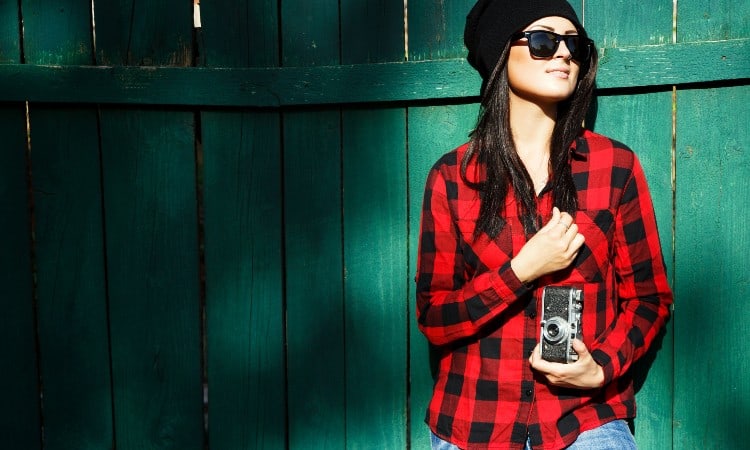
The most confusing thing about plaid is that it didn’t start as a fabric pattern. Originally, it was part of a traditional Scottish kilt outfit. A plaid was the rectangular section that draped across the shoulder. Technically it still is, particularly in Scotland and other parts of the UK.
Plaid comes from the Gaelic word for a blanket. Designed to be worn in the somewhat brisk Scottish Highlands, kilts and their matching plaids would have been woolen, making the name plaid a perfect description for a blanket worn on the shoulder.
Scottish kilts are also known for their distinctive checkered patterns. That pattern was originally known as tartan. Instantly recognizable as a pattern of uniformly placed squares in two or more colors, tartan became the name of the fabric.
Over time the name changed to tartan plaid and then just plaid, especially in the US, where the word plaid is now linked to the fabric pattern rather than a piece of clothing.
Even the pattern has changed slightly over time. While traditional tartan is made up of 6-inch squares in a uniform repeat, plaid is a bit more footloose and fancy-free.
With plaid, the squares can be different sizes within the same piece of fabric. However, they are still regular-shaped squares, and there is still a distinct format to repeat the pattern.
What Is Gingham?
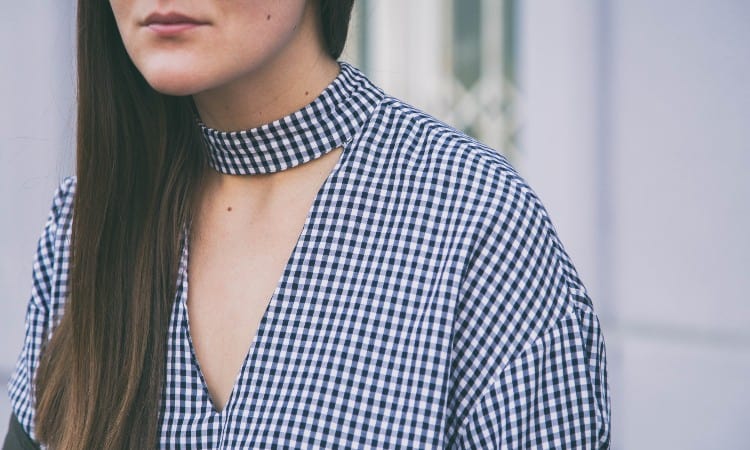
Made from cotton or a cotton blend fabric, Gingham is a material made from dyed yarn woven in a check design. It’s always the same check pattern made up of symmetrical blocks of two colors, one of which is always white.
An interesting and distinctive feature of gingham is the two-color patterning. This pattern leads many people to believe that gingham is a plaid fabric. As we saw in the section above, a plaid is a fabric containing squares of two or more colors. However, we’ll discover later in the article that the two fabrics are very different.
Popular colors for gingham include red, blue, and black. But you can also find gingham in pink, yellow, green, and purple. Never together, though. To be a true gingham, the pattern has to be white and one other color.
For an unassuming material, it has several theories regarding its origin. The French town of Guingamp was once a main producer of gingham. However, the French sometimes call the material Vichy and link its origins to that town instead.
It could just as easily be a translation from words in other languages. The Malay word for striped is genggang, while the Dutch version is gingang. It was Dutch traders who imported the material into Europe from Asia. It’s not much stretch to further adapt the word into English to get gingham.
Regardless of how the name came into being, the fabric’s pattern is instantly recognizable. Gingham is a lightweight check fabric associated with summer wear. The squares in the check are the same size throughout the material, giving a smart, uniform appearance.
It’s particularly popular for girls’ summer dresses, men’s shirts and picnic tablecloths. It became extremely popular during the depression years of the 1920s and 30s due to being cheap and easy to get hold of.
The size of the check can vary. Some gingham is a pin check with tiny squares that make the fabric look like a solid color from a distance. While others can range from ½ inch to an inch per square. You don’t usually find gingham checks larger than an inch. It is, after all, a delicate check.
Plaid vs Gingham: Key Points
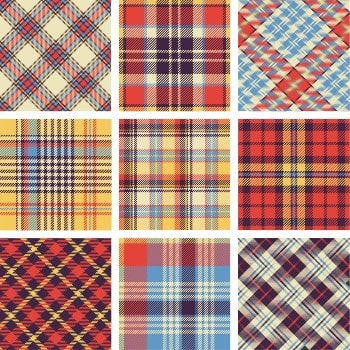
Plaid and gingham are two very different checkered fabrics. The first has a pattern that can be made up of several shades, while the latter is two colors only. That’s not the only difference between them.
Gingham is a light material suitable for summer wear. In contrast, plaid can be thicker and better suited to cooler climates. That’s down to the textiles used to make them. Plaid is usually found in mid to heavy fabrics like flannel or wool, while gingham is normally made from lightweight cotton or polycotton.
In the following table, I’ll show you the slightly less obvious differences between plaid and gingham. Seeing them side-by-side should help you determine which fabric is best for your project.
| Plaid | Gingham | |
|---|---|---|
| Appearance | Check pattern of squares that can be different sizes | Check pattern of uniformly sized squares |
| Color | Multiple colors | Always white with one other main color |
| Fabric | Cotton and cotton blends Flannel Wool | Cotton and cotton blends Polyester |
| Style | Depends on the pattern Can be smart or laid back and casual | Smart and slightly dressy |
| Uses | Men’s shirts Kilts Bed sheets Throw blanket Throw pillows | Summer dresses Men’s shirts Bed sheets Tea towels Tablecloths Kitchen curtains |
| Weight | Can be lightweight but usually mid to heavy | Lightweight |
What is the Difference Between Plaid and Gingham?
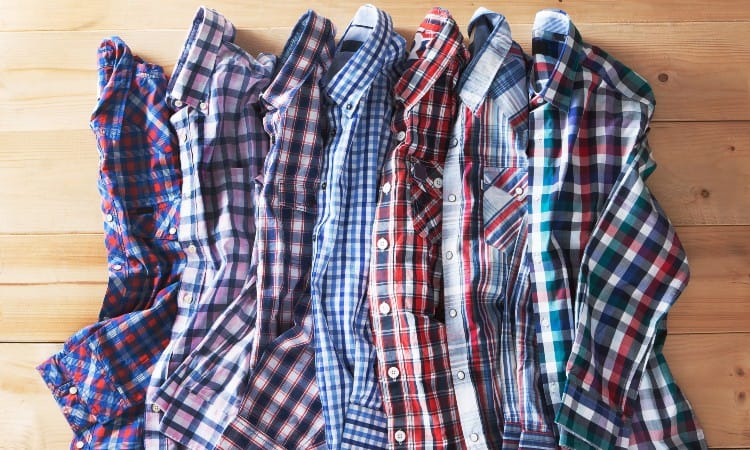
Both gingham and plaid fall under the banner of checkered fabrics. Technically, gingham is a type of plaid as it consists of a check pattern of two colors, but there is more to these two disparate fabrics than the look of the pattern.
From the overall appearance to the fiber content of the fabric, gingham and plaid are inherently different. They each have properties that make them ideal for different types of garments and uses. Let’s take a look at the main characteristics in detail.
Appearance
Plaid is a check pattern that can be two or more colors. The pattern can contain small and large squares in a regular repeat. Usually, the squares will be an inch or more in size. But not always; some can be smaller. However, although it can have small squares, the overall pattern is still robust and chunky.
Gingham has a softer design. The material is woven using just two colors. One is always white. It’s the second color that determines the shade of the fabric. So a red gingham would be red and white.
Squares in a gingham check are small and delicate. There is no variation in size within one piece of fabric. If one square is 1 inch, they will all be the same dimension.
Color
This is one area that plaid and gingham differ greatly. Plaid fabrics can be two colors, like a buffalo check. The red and black check of a buffalo plaid is possibly the most well-known design.
Plaid can also be multicolored. They can be black, white, and blue, or pink, blue, and white. There are no color restrictions with a plaid fabric. Anything goes, as long as the colors form the unmistakable plaid squares, then it qualifies as plaid.
Gingham isn’t so easygoing. To be gingham, the check has got to be white and one other color. That second shade can be any color you want, but it has to be the only color besides white. The most popular combinations are red and white and blue and white.
The blue version is particularly sought-after as it is always on-trend. It was also the type of gingham used for Dorothy’s dress in the Wizard of Oz.
Fabric
Gingham has long been associated with warm, sunny days. One of the reasons for this is the fiber content. This fabric is woven from cotton. It can also be woven from cotton blends and even 100% polyester. The key with gingham is as it’s a light weave, it works best on summery fabrics.
In contrast, plaid can be made from cotton or wool. Plaid’s history links it too chilly days out on the Scottish moors, so it tends to be made from more chunky, warmer materials and weaves. Because of this, you’ll find a plaid pattern is a popular choice for flannel fabrics.
Style
Unless it’s part of a kilt outfit, the nature of plaid tends to conjure images of laid-back nights at the pub. Or long work days chopping down trees. It’s a pattern that has become synonymous with both lumberjacks and relaxation.
It’s casual. You wouldn’t want to wear a plaid shirt with a suit. A tartan, or a plaid that looks like a tartan, can be worn to smart and formal occasions. Many a groom has worn a kilt outfit to their wedding. But it has to be the right kind of plaid.
Any style of gingham fabric can be worn as part of a smart outfit. It goes well with suits, particularly day suits. However, you do have to be careful how you wear your gingham. It has strong links with children’s wear and picnics.
For a sophisticated look, steer clear of bold colors like red. Try to stick with neutral shades like black and dark blue. Always keep patterns to a minimum too. If you are wearing any gingham, keep your other garments plain and in a complementary solid color.
Uses
The uses of gingham and plaid fabrics are driven by the material that goes into making them. Historically a plaid material, or rather a tartan, would have been made from wool. It was a fabric used to keep the cold out. Blankets, throws, kilts, and warm shirts are all good uses for plaid fabric.
Gingham is more of a home décor and summer garment fabric. Kitchen curtains, tea towels, and tablecloths can all be made using a gingham material. As well as dresses, shirts, and bedding. It’s strong and durable yet light and airy. Better still, it’s easy to clean, making it one of the most versatile fabrics you can find.
Weight
Plaid materials are usually mid to heavy-weight fabrics. They are normally made out of wool or a closely woven flannel. However, these days you can get lighter-weight plaid textiles, depending on the fabric.
Plaid patterning doesn’t have to be woven into the fabric anymore. It can be printed. This means you can get a distinctive plaid on a summer-weight shirt.
Gingham is a lightweight weave and makes a light fabric. Although you can get gingham treated with special finishes like plastic-coated tablecloths, it will still be a lightweight fabric. That’s one of its endearing and timeless charms.
Is Plaid the Same as Tartan?
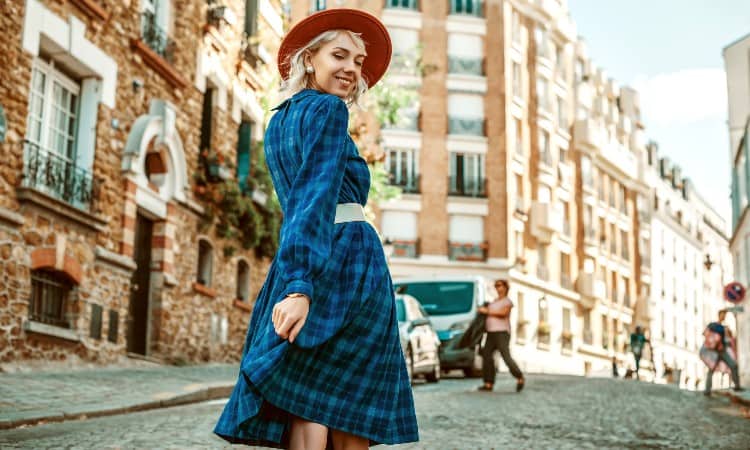
Plaid and tartan are similar. They are both checkered patterns and are linked together through their shared past. Historically, plaid was the name given to part of a kilt outfit, while tartan was the name given to the pattern on the fabric used to make the clothing. However, things are a bit different now.
Tartan has a distinctive pattern that is usually made up of 6-inch squares. There is a regular repeat throughout the material. No two tartans are identical. Originally, they would have been worn to identify the different clan members on a battlefield, kind of like a uniform.
Because of their links to individual Scottish families or clans, tartan designs are specific to that clan or group. If you aren’t a member, you can’t wear that particular tartan. Or at least, you’re not supposed to. So tartan could be considered to be akin to modern-day gang colors.
Clan tartans are officially recognized by the Scottish Tartan Authority. One such tartan would be the one belonging to the Black Watch regiment. But you can also find tartans belonging to family names like Stuart, MacDonald, and MacGregor.
In contrast, the modern definition of plaid is a tartan-type check pattern that anyone can wear. It’s a generic tartan if you like. One that doesn’t have official recognition as belonging to any particular group. Buffalo plaid is one example.
The pattern of plaid can also be irregular; rather than being one size of square throughout, some plaids can have patterns that incorporate large and small squares.
Can All Checks Be Called Gingham?
No, not all checks are gingham. There are several different styles of check fabric. This article has covered three so far. Gingham, plaid, and tartan. As we’ve seen earlier in this article, they are all slightly different.
To be a true gingham, the material has to be a check pattern of white and one other color. Not all checks are restricted to two colors. Let’s take a look at some other check patterns you may come across on your search for gingham.
Buffalo Check
The buffalo check, or buffalo plaid, does have a striking resemblance to gingham. It has a pattern of two colors that make a check design of uniformly sized squares.
However, there are two main differences between gingham and buffalo check. Gingham is a delicate pattern of small squares. Buffalo squares are bigger and more chunky-looking. Think lumberjack shirts. This is a more robust check than gingham.
A buffalo check isn’t restricted to white, either. You can get black and white squares, but the more common combination is red and black.
Houndstooth Check
This check is similar to gingham in that it can be made up of two colors, usually white and one other shade. There is one very obvious difference between the two distinct checks, though.
Houndstooth is also referred to as dogtooth. This is because the blocks of color are not squares. They are irregular shapes that look a lot like the incisor teeth of dogs, jagged with sharp points.
Another difference between houndstooth and gingham is that houndstooth doesn’t have to contain any white. You can get a houndstooth check in two different shades of brown. Or even in three colors. It’s the irregular pattern that’s important with this style of check, not the color scheme.
Windowpane Check
Also known as the graph check, the windowpane check looks like windows. The squares in the check are separated by thin lines of color reminiscent of window frames.
Instead of being an even design of regularly shaped squares in alternating colors, like gingham, the windowpane check is a series of stripes. These stripes run vertically and horizontally and are usually the same color. It’s the pattern of the stripes that form the check, not the squares.
Tattersall Check
This check has more in common with the windowpane check than with gingham. Tattersall check is a striped pattern of vertical and horizontal lines. The main difference between this check and the windowpane style is the lines can be two different colors. There are also more of them.
So instead of one large square framed by two lines of blue, you get a large square with four tiny ones inside. All are separated by lines of alternating shades.
Conclusion
Plaid and gingham are both checkered materials. But they couldn’t be more different. A plaid fabric can be chunky and warm. While gingham is delicate and summery. That contrast gives both materials their unique appeal.
Which check do you like most? Will you be using plaid or gingham in your next project? Let me know in the comments.